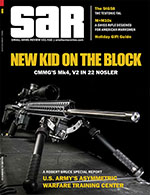Beating the .22 Magnum at Its Own Game
By Oleg Volk
When Armscor originated the 22TCM cartridge, it was perceived mainly as a pistol round. Its massive muzzle flash should have tipped us off to the promise of this round for longer-barreled firearms, and these appeared on the market shortly after the handguns. The descriptively named M22 TCM BA is a fairly simple bolt action that uses either a flush-fitting detachable five-round double-stack magazine or 17-shot magazines common to Armscor’s numerous 9x19 and 22TCM models. Utilitarian in appearance, this rifle is an impressive performer.
Launched from a 22¾-inch barrel, the 40-grain jacketed hollow point bullet achieves 2,800 feet per second. Minimal muzzle flash and mild report suggest that the powder burn is almost complete. The bullet is identical to that used in Armscor’s .22 WMR cartridge, and it achieves essentially the same velocity from the 22TCM and .22 WMR at 100 yards. In spite of this, the 22TCM keeps the bullet supersonic out to 230 yards, while the rimfire only gives it 125 yards. While the engineering of the bullet gives it consistent expansion over an impressively wide range of velocities, it performs best from right at the muzzle out to about 150 yards. Beyond that distance, sufficiently rapid expansion in small varmints becomes less certain. Also, unlike the disposable rimfire case, 22TCM brass can be reloaded several times—more than a few when fired from a bolt action and not resized full length.
Among the historic hunting cartridges, the .22 Hornet in 40-grain load happens to be an almost exact ballistic match to the 22TCM. Where the 22TCM wins is in its case dimensions, providing better extraction and easier functioning in semiauto arms through a more pronounced bottleneck, much shorter overall length and rimless configuration. Off the store shelf, the 22TCM is also about 20% cheaper than the .22 Hornet.
The bolt is unusual in design, with the front purely cylindrical and the sole locking lug hidden in the bottom of the back, right next to the bolt handle that acts as a safety lug. This configuration permits reliable feeding from detachable pistol magazines. There is no forced hold open on the last shot, but the absence of resistance makes the firearm’s empty status very obvious. The back of the firing pin also serves as a visual and tactile cocking indicator. The ability of the magazines to take either 22TCM or 9x19 enabled Aklys Defense to convert this rifle into an integrally suppressed 9mm variant. For cleaning, the bolt comes out once the latch on the left of the receiver is held down.
Out of the box, the rifle has no iron sights, only a 22-millimeter dovetail for tip-off scope rings. A raised lug on the front of the dovetail provides a positive stop against recoil, a measure that seems unnecessary given the utter lack of any felt recoil with this gun. Armscor also offers an aftermarket Picatinny rail designed specifically for this gun. Installation takes seconds. The barrel profile permits a very large front objective even with low rings, but I found that medium rings were needed to give clearance to large ocular bells. The turned-down bolt handle clears the large ocular bell also. For testing, I used a 2-7 Riton scope, a very clear optic with a bullet drop compensator (BDC) for the .22LR round, the hash marks for which I re-calculated. Instead of a 50-yard zero and 75-, 100- and 125-yard marks, the subtensions are, with a 100-yard zero, at approximately 175, 230 and 280 yards. Conveniently, 230 yards also indicates the transonic distance for the bullet.
While hefty, with a weight of over seven pounds—much of it from the free-floating barrel—this rifle is well balanced and feels lighter than it is. Likewise, the four-pound trigger is crisp and feels lighter than the actual pull gauge indicates. It comes with a rubber buttpad, unnecessary for recoil reduction but helpful for a consistent shoulder contact. Front and rear sling swivels are included, so bipod attachment is easy. Safety lever is a very positive rocker, back for SAFE and front for FIRE.
For a varmint rifle, the test is in the accuracy of shooting. My rifle shot very consistent one-inch groups at 100 yards ... So long as no more than three shots were fired in a row. Once the barrel heated up, the bullets would string vertically. It took a trip to a knowledgeable gunsmith, Kyle Cobb of Lascassas, TN, to figure out the culprit. Somehow, this specific sample—admittedly, a pre-production prototype—left the factory with the action screws installed crooked. Once that was fixed, the rifle shot consistent 1MOA groups with five shots even from a warm barrel. That’s perfectly adequate for a sub-200-yard varmint rifle.
At this time, only Armscor loads 22TCM ammunition. They are perfectly happy to sell primed brass to other loaders, so I hope to see at least one specialty ammunition maker offer cartridges with target and expanding bullets in the near future. Given the popularity of the rifle and the correspondingly large amount of user feedback, Armscor is working on a second version, with an integral Picatinny rail, much nicer stock and a muzzle threaded for sound suppressors.
For users of 22TCM pistols, this rifle is an obvious companion. While ballistically inferior to the .223 Remington, the 22TCM enjoys milder report, no muzzle flash and shorter bolt travel for rapid follow-up shots. This specific rifle model is just plain fun to shoot—good thing the ammunition comes in 50-round boxes!
This article first appeared in Small Arms Review V21N10 (December 2017) |
| SUBSCRIBER COMMENT AREA |
Comments have not been generated for this article.








